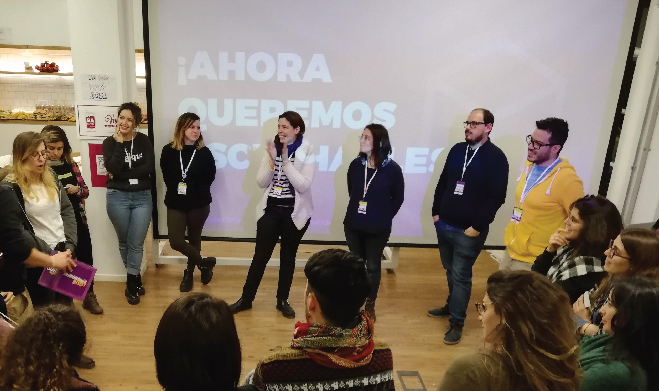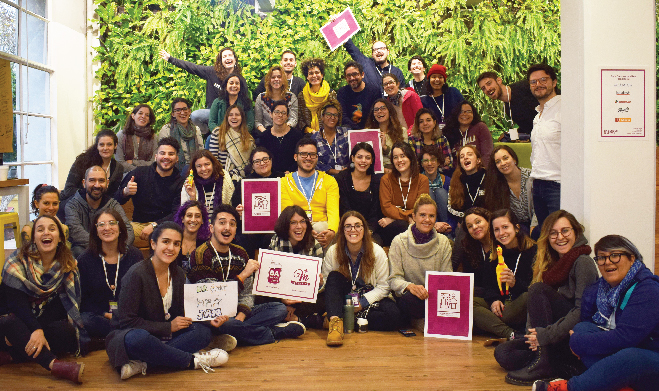Earlier this winter (summer in the northern hemisphere), I enjoyed facilitating the first-ever Gender Jam in Buenos Aires, Argentina. The event was organized by Buenos Aires Service Jams, the local chapter of the Global Service Jams – a non-profit and volunteer-based network of service design aficionados – and MásMujeresUXar, the local chapter of Mas Mujeres Ux, a community of women from Latin America who work in user experience and try to empower women in technology and enhance their visibility through workshops and access to educational courses.
Gender-Inclusive Hackathon
The event consisted of a ‘hackathon style workday,’ in which participants were provided 48 hours to improvise, build, and create services based on a specific theme. The event theme asked dozens of participants to consider the extent to which gender affects design and, if possible, to introduce ‘gender perspective’ into the design of the day-to-day services. Throughout the weekend, participants were supported by user-centered methodologies to design and build real-life prototypes of the solutions they discovered.

A Design Thinking Methodology
Event participants followed a traditional design thinking process; as such, they began by brainstorming ideas and collectively prioritized which topics would better suit the challenges they wanted to approach. They then engaged in various ideation techniques and validated their insights with assistance from people residing in the neighborhood surrounding the event’s location.
Armed with those findings, event participants prototyped their service solutions and went out again to test their prototypes. After some iterations, participants presented their findings – including the pain points about each of the themes they decided to study.
Topics Presented & Guest Speakers
During the event, attendees discussed the following topics:
- False Neutrality, with Griselda Flesler.
- What Is a Gender Perspective, with Belén Sanchez.
- Transgender Patient Identification, specifically discussing an inclusive form design by the Technology Department of the Hospital Italiano of Buenos Aires.
Griselda Flesler, who teaches the “Design and Gender Studies” class in Argentina’s National University, FADU-UBA, delivered the keynote address. Griselda also serves as coordinator of the Gender Unit of the General Secretary of FADU.
During her lecture, she discussed “false neutrality” in design. Griselda analyzed how gender has affected the design of products and services throughout the centuries, as well as the tacit understanding that there is almost always a gender-biased chain of thought in the decision-making process.
She emphasized the concept that gender ideologies have a direct impact when choosing some styles of design over others. Indeed, she shared that in her faculty lectures, she tries to open a dialog that examines the rhetoric of neutrality and provides awareness about the importance of adding a gender perspective into the design thinking process. The goal, she states, is to derive an inclusive and flexible deliverable that embraces a more ‘genderless’ and universal approach to how we articulate design projects.
The event also included a “gender clinic,” which offered participants the opportunity to get important advice on a variety of gender-based topics. Available for consultation were specialists in the field of anthropology, a consultant from Bridge the Gap (an organization that promotes gender equality and inclusive leadership in work environments), a member of the Buenos Aires Gender Observatory of Justice, and a service designer specialized in sensitive service design.
A Gender Perspective in Future Design
As the activities concluded and Gender Jam drew to a close, attendees departed with a clear understanding about the importance of applying a gender perspective in the initial phase of any project. In the same way design thinking techniques taught us ‘Empathy is everything,’ Gender Jam deepened our awareness that ‘Empathy without introspection cannot exist.’ Therefore, to deliver a more universal perspective, we must first understand the gender stereotypes and privilege we may be perpetuating through our designs; and in that way, we open our eyes to more universal and inclusive designs that serve a much broader array of users with products and services that improve their lives.
In the same way design thinking techniques taught us ‘Empathy is everything,’ Gender Jam deepened our awareness that ‘Empathy without introspection cannot exist.’ — Nicole Btesh,UX/UI Interaction Designer, ITX Corp.
Just to gain some context, this Jam was established as a way of starting conversations that incorporate gender perspective into the design of products and services. Argentina is experiencing a strong feminist movement that is slowly clearing a path for more inclusive language and product design, as well as an array of protocols that seeks to involve all people without regard for gender and sexual orientation.
Supporting a More Inclusive Society
Therefore, I strongly believe that it’s imperative to encourage our broader society to accommodate and support events like Gender Jam, in which people from diverse backgrounds can come together in an environment to share their spirit while feeling safe to consider the services of the future with a different perspective – one that breaks with the traditional male-dominated way of thinking. For that reason, this Jam in particular served as a way of introducing gender as a key topic in today’s social agenda, by bringing gender issues to the forefront and challenging the status quo.
This Jam also identified which gender stereotypes continue to pervade contemporary society and examined how frequently a gender-biased perspective plays an oppressive role and encourages an unfriendly environment to people who refuse to be defined by their gender identities.

What’s Next?
In addition to bestowing a gender perspective among colleagues and students, going forward the plan is to replicate Gender Jam in different countries so that the global chapter of Service Design Jam can incorporate it into its annual array of events.
Learn more about designing for inclusion with the ITX ebook:
Getting Started with Product Inclusion – An imperfect guide to thinking bigger and building better digital experiences.



